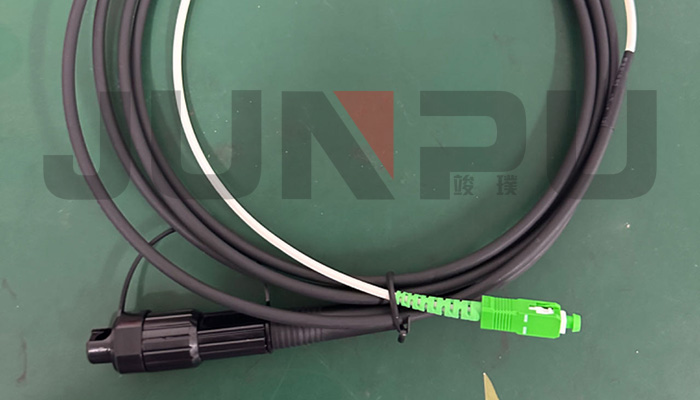
-
Home
-
Products
- Solution
- WHY JUNPU
- Services
- Resources
- News
- Contact Us

A drop cable patch cord is a fiber optic cable used to connect fiber optic network devices. It is usually used to connect fiber optic terminal equipment and fiber optic distribution boxes.
The main purpose of the drop cable patch cord is to transmit data signals in fiber optic networks and is used to connect different fiber optic devices, such as fiber optic switches, fiber optic routers, fiber optic terminal equipment, etc.
In fiber optic networks, drop cable patch cord plays an important role in connecting different devices, which can ensure the fast transmission and stability of data signals. By using drop cable patch cord, efficient communication between fiber optic network devices can be achieved, and the performance and reliability of the network can be improved. Therefore, drop cable patch cord plays a very important role in fiber optic networks.
A patch cable in optical fiber, also known as a fiber optic patch cord, is a type of cable used to connect optical devices such as fiber optic transceivers, switches, and routers. It consists of a fiber optic cable terminated with connectors on both ends, allowing for the transmission of data signals between different components of a fiber optic network.
Patch cables are typically used for short-distance connections within a data center, telecommunications room, or other networking environments. They come in various lengths, connector types, and fiber types to accommodate different network configurations and requirements.
Patch cables play a crucial role in ensuring the efficient and reliable transmission of data signals in optical fiber networks. They provide a convenient and flexible way to establish connections between various fiber optic devices, helping to maintain the performance and integrity of the network.
Fiber optic drop cables: These cables are used to connect a distribution network to individual homes or businesses. They are typically made of lightweight and flexible fiber optic strands that can transmit data at high speeds.
Coaxial drop cables: These cables are commonly used in cable television and internet installations. They consist of a copper core surrounded by insulating material and a protective outer layer. Coaxial drop cables are designed to carry high-frequency signals with minimal interference.
Ethernet drop cables: These cables are used to connect devices to a local area network (LAN) or the internet. They are typically made of twisted pairs of copper wires and are available in various categories (such as Cat5e, Cat6, and Cat7) to support different data transmission speeds.
Power drop cables: These cables are used to deliver electrical power from a distribution network to individual buildings or devices. They are typically made of copper conductors and are insulated to prevent electrical shocks or short circuits.
Telephone drop cables: These cables are used to connect individual telephone lines to a main distribution network. They are typically made of twisted pairs of copper wires and are designed to carry voice signals with minimal interference.

A "Patch cord" is a cable that connects electronic devices, usually used to connect computer network equipment, telephone systems, and other equipment. It usually has a connector, such as an RJ45 connector or an LC connector, for quick plug-in and unplug connection of equipment. Ordinary "cable" refers to general cables, which may not have connectors and are more widely used.
In fiber optic networks, "patch cords" are usually used to connect fiber optic equipment, such as fiber optic switches, fiber optic routers, etc. They usually have fiber optic connectors, such as LC, SC, or ST connectors, to connect different fiber optic equipment. Ordinary "cables" may not be suitable for connecting fiber optic equipment because they may not have fiber optic connectors.
"Drop cable patch cord" is a special type of "patch cord" used to connect "drop cable" in fiber optic networks. It usually has a fiber optic connector and a standard connector, such as an RJ45 connector, for connecting to equipment. Due to the presence of connectors, it is more convenient to use "patch cords" to connect network equipment, which can be quickly plugged and unplugged and is convenient for maintenance and replacement of equipment. Using ordinary "cables" may require more steps and time to connect equipment.
Therefore, "patch cords" with connectors are more convenient in network connections, especially when used in fiber optic networks. They can quickly connect devices, reduce maintenance time, and improve network efficiency.
FTTH (Fiber to the Home): In a fiber-to-the-home network, users need to connect the fiber network to devices inside the home, such as optical modems, routers, etc. Using "drop cable patch cord" can easily connect the fiber network to home devices and achieve fast network access.
FTTB (Fiber to the Building): In a fiber-to-the-building network, the fiber network is usually connected to different floors or rooms in the building. Using "drop cable patch cord" can quickly connect fiber networks on different floors or rooms to achieve flexible network wiring.
Convenient connection: Due to the connector, the use of "drop cable patch cord" can quickly plug and unplug the connection device, which is convenient for maintenance and replacement of equipment.
Durability: "Drop cable patch cord" is usually made of high-quality materials, has good durability, and can work stably for a long time.
Indoor and outdoor adaptability: Because "drop cable patch cord" has good waterproof and dustproof properties, it can be used in indoor and outdoor environments to adapt to different installation scenarios.
In general, "drop cable patch cord" plays an important role in fiber optic network applications such as FTTH and FTTB. Their convenient connection, durability, and indoor and outdoor adaptability make them an important part of network cabling.
 Call us on:
Call us on:  Email Us:
Email Us:  Wanhua Science and Technology Park, No. 528, Shunfeng Road, Donghu Street, Linping District, Hangzhou City, Zhejiang Province
Wanhua Science and Technology Park, No. 528, Shunfeng Road, Donghu Street, Linping District, Hangzhou City, Zhejiang Province